by Winding Pathways | Apr 4, 2019 | Birds, Garden/Yard, Nature
As lingering snow banks melt we look forward to the arrival of our favorite spring guests. They arrive in late April, but we put out the welcoming mat a month ahead.
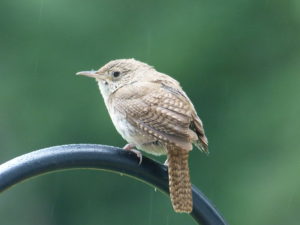
We welcome the wrens each spring
For many years a pair of house wrens have nested right outside our dining room window. We laugh at their bubbly energy and enjoy watching them bring caterpillar after caterpillar into their home to feed growing babies. In some years we get to watch as the youngsters peer outside their nest box before taking their first awkward and short flight.
How Many Species live in the United States?
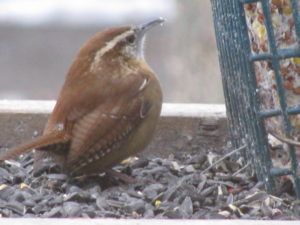
Sometimes the Carolina wrens stay around in winter.
House wrens are only one of six wren species that live in the United States. We’re fortunate to have both house and Carolina wrens in our
yard. Carolinas don’t migrate, so we sometimes see one feeding on suet in winter. House wrens are, perhaps, wiser and leave Iowa each October to winter down along the Gulf Coast.
It’s almost magical when the house wrens return each late April. Suddenly the air is filled with their delightful song. We usually hear them before we spot their nervous energy as they seek a nesting location. The nest boxes we set up in March are their welcome mat.
Making a Birdhouse
Few birds are as easy to lure into a nest box as house wrens. In winter we make new ones out of scrap lumber. Wrens aren’t fussy. Many elaborate nest boxes can be purchased but all it takes to make one is a four-foot section of 1X6 inch pine lumber, a few nails, and simple tools. We like the plans posted on Birdwatching Bliss.
We’re crude carpenters but the birds don’t seem to mind if the joints aren’t perfect.
Many wren house plans call for a circular opening of 1 1/8th inch but we’ve had great success with a one-inch hole. Larger holes welcome messy house sparrows. We also never place a perch in front of the entry hole. Wrens are acrobatic flyers and have no trouble entering a hole without a perch nearby.
Entertainment
Few birds are as entertaining as bubbly house wrens, but there’s another reason we love having them around. They’re voracious predators of insects that love feasting on our garden crops, so our wren tenants help boost our vegetable crop.
Wrens start nesting almost as soon as they arrive. Their nest is carefully made of small sticks that nestle a few reddish spotted eggs that hatch in about two weeks. Babies grow like fury and leave the nest by the end of June. We then clean the nest out of the box, and often the eager parents produce a second brood in the late summer.
No bird is as likely to fascinate a child as a pair of bubbly wrens nesting in full view just outside the window.
-
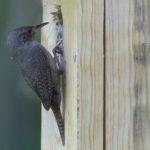
-
Checking the nest box.
-
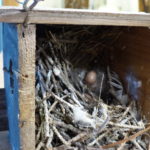
-
Eggs are spotted reddish
-
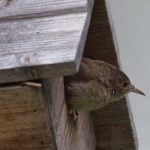
-
Looking out at the world.
by Marion Patterson | Mar 14, 2019 | (Sub)Urban Homesteading, Chickens, Garden/Yard
In the past few years, thousands of Americans have begun tending small flocks of chickens in their backyards. For most folks, it’s a new hobby, but we’ve been at it far longer. Rich began raising chickens in his suburban backyard when he was eight or nine years old – over 60 years ago. Marion’s family raised chickens at their New Hampshire home.
This spring many chicken newcomers will install a coop, raise chicks, and produce delicious food in their yards. It can be complicated, so this blog is designed to explain chicken husbandry in its very simplest form. Many books in most libraries and websites on chicken culture give detailed chicken care information and are outstanding resources. We recommend checking Hoover’s Hatchery. It offers a printed catalog, an online catalog, and website blogs. We also do a Facebook Live program each month for Hoover’s about different aspects of chicken care. Also see Scoop from the Coop for detailed information.
Chicks
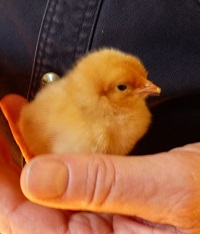
Baby chicks can be purchased on line.
Baby chicks can be purchased online. Most hatcheries require a minimum order of 15 or 25 babies, usually more than most families want. Smaller quantities can be purchased at farm stores, such as Tractor Supply. Many cities have ordinances allowing chickens but usually limit the flock size to six or fewer birds. Check your local ordinance before buying.
Chicks come in dozens of different breeds, but we suggest choosing those that lay brown eggs. These breeds are fairly large bodied, calm birds. Our long-term favorites are New Englanders like the Rhode Island or New Hampshire Reds, or the Barred Plymouth Rock. Other great breeds are Wyandottes, Orpingtons, and Australorps. White egg breeds, like Leghorns, lay like crazy but are more nervous and noisier than brown eggers.
Often, it’s possible to buy a variety of breeds. Having a six hen flock composed of six different breeds is colorful and fun.
Housing
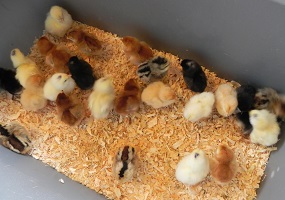
Chicks need to be warm until their insulating feather grow.
Baby chicks need to be warm until their insulating feathers grow. They are reared in a device called a brooder. A simple one can be made with items most people have around the house. See the blog on building a brooder on Hoover’s Hatchery Website for detail.
By the time the babies are six weeks, or so, old they need to move into permanent quarters, the chicken coop. The easiest way for a family to start is to buy a pre-made coop online or at a farm store. These range in size from tiny ones that will fit just a couple of hens to those that might fit up to a dozen. It’s a good idea to have an attached outside fenced in area, called a run, so the hens can enjoy fresh air and sunshine. Building a coop isn’t difficult and plans are printed in most basic chicken books or can be downloaded from websites.
Chicken houses need fluffy bedding, called litter, covering the floor. Pine chips work great. Bales of chips can be bought at farm stores. Every coop should have a nest for hens to lay their eggs in and a pole installed parallel to the floor for them to roost on. Yup, chickens sleep standing up.
The house should have windows that can be closed to prevent cold winter drafts but open to welcome fresh summer air. Cover windows with mosquito mesh and heavy wire to discourage both bugs and raccoons. Neighborhood raccoons would love a chicken dinner, so keep them out of the coop!
Food and Drink
Stores that sell baby chicks almost always sell feed. Babies need a high protein mash called Chick Starter from the time they hatch until they lay their first egg. Then switch to Layer feed. Simple inexpensive feeders are sold in farm stores. Chickens love drinking fresh water so invest in a water fount and keep it full. Hens enjoy a handful of corn every once in a while, as a treat. They also love table scraps. We give ours bits of rice, squash seeds and hulls, meat scraps and a few other things. As with all treats, we keep portions small.
The Nutshell

Raising chickens helps kids learn care and responsibility.
This is chicken husbandry in a nutshell. There’s lots more to it, so be sure to read websites and books on chicken care before buying your first batch of chicks. If you are lucky you can take a backyard chicken basic class at a nearby nature or garden center.
by Winding Pathways | Mar 7, 2019 | (Sub)Urban Homesteading, Garden/Yard, Trees
Catalog Dreaming
While subzero cold enveloped Winding Pathways we discovered delightful seed and nursery catalogs in our mailbox. Leafing through their photos of rosy ripe tomatoes, peaches, and sweet corn made us dream of warm days as the frigid wind whistled around the house. Catalogs also made us think of our upcoming cherry tree crop.
We love our cherry trees and are happy to have two types growing at Winding Pathways. Most are the wild native Black Cherry, a member of the Rose family and common throughout the Eastern half of the United States.
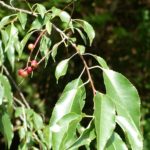
Black cherry juice was mixed with brandy or rum to make “Cherry Bounce.”
Early pioneers sometimes called this tree the Cherry Bear because bruins would walk for miles to feast on its juicy fruit. Bear cubs learned how to climb trees by following their mother up the trunk to reach ripe fruit.
Birds love wild cherries. They’ve helped spread this tree far and wide by feasting on a cherry dinner here and then flying there to poop out the seeds. In many areas, the American Black cherry is almost an invasive species, but one with many attributes.
Thomas Jefferson’s Cherry Tree Wood
People today rarely bother eating the bitter small fruits, but pioneers made Cherry Bounce by mixing the juice with brandy or rum to make a bitter, but flavorful, cordial. Most people today enjoy this tree for its beautiful cabinet wood. When newly cut it is goldish in color, often with an intricate grain pattern. The wood darkens with age. Visitors to Thomas Jefferson’s home, Monticello, Charlottesville, Virginia, often wonder why our third president loved such dark paneling. They don’t realize that when he lived there the newly installed wood glowed with cherry’s warm texture. Two centuries of aging have darkened it.
In our mail recently came the newsletter of the National Arbor Day Foundation with an amazing story about today’s popular Bing Cherry. That’s the delicious fruit often sold in grocery stores to be eaten fresh. In 1847 Henderson Lewelling, of Salem, Iowa, loaded his eight children, pregnant wife, and 700 of his prized cherry tree shoots packed in dirt-filled boxes, into wagons for the long trek to Oregon. They endured freezing temperatures, scurvy, and dysentery but made it and established the Pacific Northwest’s cherry industry.
Two Types
Today, two types of domestic cherry are readily eaten by people. They are distinct from the American Black Cherry and are native to Europe and Asia. One type is called Sweet Cherries with the Bing variety best known. They are delicious when eaten fresh. Sweet cherries thrive in California, Oregon, Washington, Idaho and Montana but don’t like the upper Midwest’s harsh winters. Ironically, Bing cherries got their start in Iowa but don’t grow well in the state today. We don’t have any at Winding Pathways.
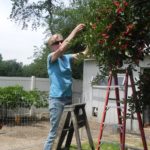
Tart cherries make great pies.
We love our sour cherries. They thrive here despite winter’s cold and summer’s inferno, yielding an abundant crop in June. Most commercial sour cherries are grown in Michigan, but they love Iowa. Our favorite variety is the Dwarf North Star. It resists bugs and diseases, and even the deer leave it alone. In some years our cherry crop is almost sweet enough to eat fresh. We love them best blended with mulberries in a pie or mixed into oatmeal. A handy cherry pitter removes some of the tedium of evicting the big seed from each fruit.

Tart cherries come ripe in June.
Planting a sour cherry in the yard yields delicious fruit for a family to enjoy. Dwarf varieties can be bought from many nurseries. They like full sun and don’t take much space. In contrast, plant an American Black Cherry and eventually, it will produce fruit savored by birds. The tree needs plenty of space. It can grow to 100 feet tall and likes full sun.
Two Great Sources to Learn About Trees

Elegant lodging awaits at the Lied Lodge.
The Arbor Day Foundation, arborday.org has a wealth of information about trees and sells dozens of species at low cost. A few years ago, we enjoyed a delightful visit to Arbor Day Farm in Nebraska City, Nebraska. We overnighted in the Lied Lodge on the property and wandered trails while enjoying tree lure. Adjacent is the home of J. Sterling Morton, Arbor Days founder.
A wonderful old book on tree natural history is a two-volume series called A NATURAL HISTORY OF TREES OF (Eastern or Western) NORTH AMERICA. If you find one at a used book store…….buy it!
ARBOR DAY
Most northern states honor Arbor Day on the Fourth Friday of April each year, but many southern states celebrate it at seasons more appropriate for planting in their climate. Arbor Day dates for all states are listed on this link.
by Winding Pathways | Jan 9, 2019 | Birds, Garden/Yard, Mammals, Nature
When the next soft snow falls, go tracking outside! A late December 2019 skiff of snow delighted us. There was not enough of the white stuff to shovel but the thin white blanket that covered our yard revealed who visited the night before.
The dimples of deer tracks were clearly visible as we went out to get the newspaper, but one set of tracks was unusual and especially interesting. Four footprints, in a rough line, kept repeating with about three feet of untrod snow between them. Just what animal created them?
-

-
A skiff of snow is best for tracking.
-

-
Gottcha!
-

-
A small bird left tracks in the snow.
After a bit of sleuthing, we decided it was a coyote out seeking a mouse or rabbit dinner. Coyotes aren’t rare around our home but they aren’t in the yard often. We wish we could have watched it lope across the yard.
A skiff of snow makes for a delightful walk in the woods, grasslands, or wetlands. Often animals are easy to spot as their dark coats contrast with the white snow and tracking is superb. It’s usually not hard to figure out what animal made the tracks, and following them gives some idea of what the animal was doing and where it was going.
Many Websites and books help with track identification but we like www.naturetracking.com because it shows tracks of animals most likely to be in a backyard.
Happy tracking.
-
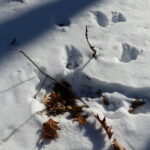
-
Squirrels at work.
-
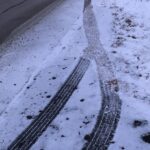
-
Even humans leave tracks all over.
-

-
Deer paths are most obvious in deeper snow.
by Winding Pathways | Jan 3, 2019 | (Sub)Urban Homesteading, Chickens, Garden/Yard
An outdoor run gives chickens more than fresh air and a place to exercise. Delicious tidbits are waiting to be discovered outside and break the monotony of daily mash or pellet meals.
Hens find food in even the smallest runs. Unfortunately, they quickly consume green grass yet still find earthworms and grubs while scratching. Occasionally they’ll even snatch a fly from the air, and if they can run down and catch a wandering mouse they’ll soon convert it to high protein food. At Winding Pathways our run is enormous, so our chickens enjoy greenery and insects all summer.
When the ground freezes and the snow flies the run remains a place for exercise, sunshine, and fresh air but there’s not much to eat there. Chickens are forced to dine on the same commercial mash day after day. It meets their nutritional needs but is boring!
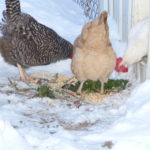
Chickens love treats.
We jazz up their diet with tasty snacks from our kitchen and mealworms.
Fortunately, chickens, like most humans, are omnivores and enjoy a diversity of food. They love most table scraps. On a cold winter morning a handful of leftover bread, pizza crust, salad bits, and meat or fish scraps is enthusiastically devoured.
We accumulate kitchen scraps in a small stainless-steel seamless bucket that’s easy to clean. Each morning we carry it outside. As soon as the hens see one of us carrying the bucket, they run toward us. Our compost bin is immediately outside the chicken run, making it easy to toss the foods chickens will eat into the run and drop the rest in the composter. Generally vegetable and fruit peels get composted while the rest goes into the run. Some people smash eggshells and give them to chickens, but we prefer composting them. By spring our composter has transformed the scraps we don’t give to chickens and decomposing coop litter into outstanding compost for the garden. At Winding Pathways everything organic is used and most is returned to the soil.
Every afternoon our hens get a special treat – a scoop of mealworms. They absolutely love them, and we use them to help manage the flock.
According to Cesar, Director of Marketing at Mealworms By the Pound, mealworms are an ideal chicken food supplement. Nearly all dried mealworms are produced in China. “They keep about two years as long as they’re stored in a sealed container,” he said.
We bought a 30-pound bag of the dried bug larvae in the fall. They’re expensive so we feed them sparingly as a special treat. We store the mealworms in a metal trash can with a tight-fitting lid and give the hens a small scoop every day. Thirty pounds last all winter. Small bags of dried mealworms can be bought in most stores that sell chicken feed or ordered online.
Our hens love them so much that they come running when we announce, “MEALWORM TIME!” with a husky voice. That’s especially helpful during afternoons when we want to close the pop hole door before sunset. We simply yell “MEALWORM TIME!”, scatter worms inside the coop, and close the pop hole door as soon as all the girls enter.
People tire of monotonous food served every day, and so do chickens. Commercial mash is an outstanding feed but giving hens special treats livens up their day.
by Winding Pathways | Dec 13, 2018 | Garden/Yard, Pests
Lots of boxelder bugs are traipsing through homes this winter to the consternation of human occupants. We reluctantly share our home with a few during cold months.
This amazingly common and crafty insect is a true bug named for common boxelder tree. You don’t have to have boxelder trees nearby to “enjoy” visits by the bug. Maples and ash trees of several species make suitable hosts. Since these trees are everywhere in suburbia it’s no wonder boxelder bugs pester so many people. The insect makes its living feeding on tree seeds and sap yet poses no threat to its host. Unlike the pests of many other trees, boxelder bugs don’t kill trees.
Come fall box elder bugs prepare for cold weather by tucking themselves into bark crevices to patiently wait out the cold. However, they would rather be warm. If a house is nearby, they seem to sense that soon the furnace will be going and indoors is the best place to overwinter.
How Boxelder Bugs Get In
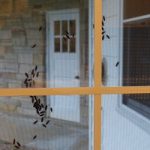
All this winter box elder bugs have gathered on warm sunny sides of homes.
Although they are fairly large insects boxelder bugs can crawl through tiny cracks and holes. Often, they swarm in the sun on the exterior of a house and some manage to find their way inside. Winter is spent idly exploring light fixtures, furniture, and walls.
They are not really a serious pest. Pesky might be a better way to describe them. Boxelder bugs neither bite nor sting. They do sometimes crawl on people and pets. Perhaps their most disagreeable characteristics are pooping and emitting a disagreeable odor if they are crushed. It’s this bad odor that protects them from predators. Hardly anything will eat a boxelder bug.
Getting Rid of Boxelder Bugs in Your Home
Want to rid the house of boxelder bugs? The best defense is a caulking gun. Late each summer seal up cracks that allow them to squeeze into the house. Look for cracks and holes around window and door frames and around wires and pipes leading into the home. Bugs discovered wandering around inside can be vacuumed up, and a shop vac can suck up hundreds sunning on the exterior. Dump them in soapy water and they’ll quickly drown. A hose can also knock them off an exterior wall. Insecticides kill them but perhaps create more problems than they solve. Some people report that spraying them with soapy water also kills them.
We’ve had some success at Winding Pathways in reducing the number of bugs we pick off walls and windows in the winter. We used to bring in a week’s worth of firewood and stack it near the woodstove. For years we didn’t realize boxelder bugs were hiding in the wood. Once they warmed up the insects set out exploring the house. Now we leave wood outside and only bring in a few pieces that go directly into the stove. It’s reduced, but not eliminated, the number of boxelder bugs inside.
Boxelder bugs aren’t harmful, but they are pesky and goofy. Caulking a home’s cracks can encourage them to winter outdoors in trees, rather than in homes. One speaker on Science Fridays quipped, “Boxelder bugs have nowhere to go and all day to get there.”




















